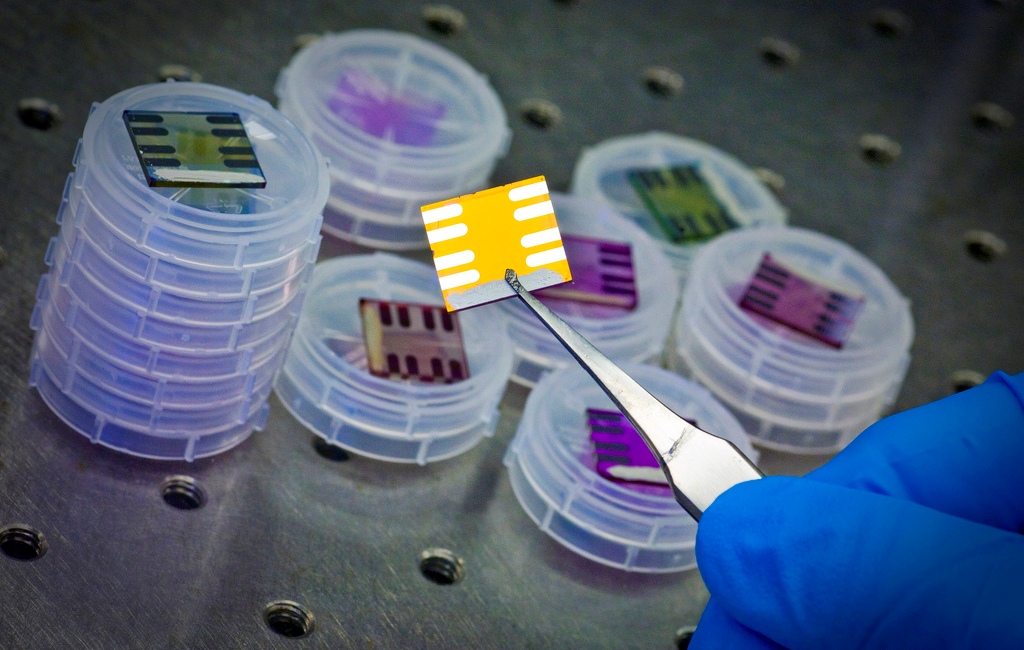Home > Press > NSF and DOE Announce Joint Funding Opportunity for Solar Energy Research
 |
| More efficient and cost-competitive solar cells could bring America significantly closer to a sustainable energy future.
Credit: Lawrence Berkeley National Laboratory/Roy Kaltschmidt |
Abstract:
The National Science Foundation (NSF) and the U.S. Department of Energy (DOE) will jointly provide up to $39 million for research to improve photovoltaic (PV) cell performance and reduce module cost for grid-scale commercial applications. The agencies released a joint Funding Opportunity Announcement (FOA) for the "Foundational Program to Advance Cell Efficiency" on April 8, 2011, to identify and fund solar device physics and PV technology research and development.
NSF and DOE Announce Joint Funding Opportunity for Solar Energy Research
Arlington, VA | Posted on April 12th, 2011This collaborative effort is one of four programs in the SunShot Initiative recently announced by Energy Secretary Steven Chu. The SunShot Initiative aims to make solar energy technologies cost-competitive with other forms of energy by reducing the cost of solar energy systems by about 75 percent before 2020. Reducing the total installed cost for utility-scale solar electricity to roughly $1 per watt will result in rapid, large-scale adoption of solar electricity across the country. Reaching this goal will re-establish American technological leadership, improve the nation's energy security, and strengthen U.S. economic competitiveness in the global clean energy race.
SunShot's Foundational Program to Advance Cell Efficiency addresses the technical foundations of PV by taking advantage of the complementary roles of NSF and DOE. NSF's mission to support basic research and educate the next generation of engineers and scientists "feeds the pipeline" to DOE's applied research and later-stage development that matures technologies toward U.S. economic impact.
"NSF aims to create breakthroughs for sustainable energy through its investment in basic research," said Robert Trew, director of the NSF Division of Electronic, Communications, and Cyber Systems (ECCS). "We hope this collaboration with DOE will bring America significantly closer to a sustainable energy future."
-Cecile J. Gonzalez, NSF-
####
About National Science Foundation
The National Science Foundation (NSF) is an independent federal agency that supports fundamental research and education across all fields of science and engineering. In fiscal year (FY) 2010, its budget is about $6.9 billion. NSF funds reach all 50 states through grants to nearly 2,000 universities and institutions. Each year, NSF receives over 45,000 competitive requests for funding, and makes over 11,500 new funding awards. NSF also awards over $400 million in professional and service contracts yearly.
For more information, please click here
Contacts:
Media Contacts
Joshua Chamot
NSF
(703) 292-7730
DOE, (202) 586-4940
Program Contacts
George Maracas
NSF
Division of Electrical, Communications,
and Cyber Systems (ECCS)
Program for Energy, Power,
and Adaptive Systems (EPAS)
(703) 292-8339
Minh Le
DOE Office of Energy
Efficiency and Renewable Energy (EERE)
Solar Energy Technologies Program (SETP)
(202) 287-1372
Copyright © National Science Foundation
If you have a comment, please Contact us.Issuers of news releases, not 7th Wave, Inc. or Nanotechnology Now, are solely responsible for the accuracy of the content.
| Related News Press |
News and information
![]() Researchers develop molecular qubits that communicate at telecom frequencies October 3rd, 2025
Researchers develop molecular qubits that communicate at telecom frequencies October 3rd, 2025
![]() Next-generation quantum communication October 3rd, 2025
Next-generation quantum communication October 3rd, 2025
![]() "Nanoreactor" cage uses visible light for catalytic and ultra-selective cross-cycloadditions October 3rd, 2025
"Nanoreactor" cage uses visible light for catalytic and ultra-selective cross-cycloadditions October 3rd, 2025
Govt.-Legislation/Regulation/Funding/Policy
![]() New imaging approach transforms study of bacterial biofilms August 8th, 2025
New imaging approach transforms study of bacterial biofilms August 8th, 2025
![]() Electrifying results shed light on graphene foam as a potential material for lab grown cartilage June 6th, 2025
Electrifying results shed light on graphene foam as a potential material for lab grown cartilage June 6th, 2025
![]() Institute for Nanoscience hosts annual proposal planning meeting May 16th, 2025
Institute for Nanoscience hosts annual proposal planning meeting May 16th, 2025
Announcements
![]() Rice membrane extracts lithium from brines with greater speed, less waste October 3rd, 2025
Rice membrane extracts lithium from brines with greater speed, less waste October 3rd, 2025
![]() Researchers develop molecular qubits that communicate at telecom frequencies October 3rd, 2025
Researchers develop molecular qubits that communicate at telecom frequencies October 3rd, 2025
![]() Next-generation quantum communication October 3rd, 2025
Next-generation quantum communication October 3rd, 2025
![]() "Nanoreactor" cage uses visible light for catalytic and ultra-selective cross-cycloadditions October 3rd, 2025
"Nanoreactor" cage uses visible light for catalytic and ultra-selective cross-cycloadditions October 3rd, 2025
Energy
![]() Sensors innovations for smart lithium-based batteries: advancements, opportunities, and potential challenges August 8th, 2025
Sensors innovations for smart lithium-based batteries: advancements, opportunities, and potential challenges August 8th, 2025
![]() Simple algorithm paired with standard imaging tool could predict failure in lithium metal batteries August 8th, 2025
Simple algorithm paired with standard imaging tool could predict failure in lithium metal batteries August 8th, 2025
Solar/Photovoltaic
![]() Spinel-type sulfide semiconductors to operate the next-generation LEDs and solar cells For solar-cell absorbers and green-LED source October 3rd, 2025
Spinel-type sulfide semiconductors to operate the next-generation LEDs and solar cells For solar-cell absorbers and green-LED source October 3rd, 2025
![]() KAIST researchers introduce new and improved, next-generation perovskite solar cell November 8th, 2024
KAIST researchers introduce new and improved, next-generation perovskite solar cell November 8th, 2024
![]() Groundbreaking precision in single-molecule optoelectronics August 16th, 2024
Groundbreaking precision in single-molecule optoelectronics August 16th, 2024
![]() Development of zinc oxide nanopagoda array photoelectrode: photoelectrochemical water-splitting hydrogen production January 12th, 2024
Development of zinc oxide nanopagoda array photoelectrode: photoelectrochemical water-splitting hydrogen production January 12th, 2024
|
|
||
|
|
||
| The latest news from around the world, FREE | ||
|
|
||
|
|
||
| Premium Products | ||
|
|
||
|
Only the news you want to read!
Learn More |
||
|
|
||
|
Full-service, expert consulting
Learn More |
||
|
|
||








